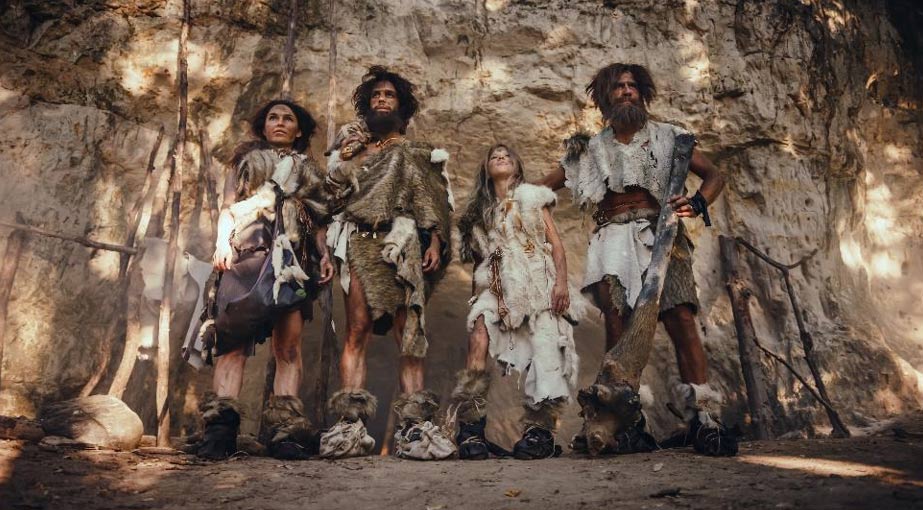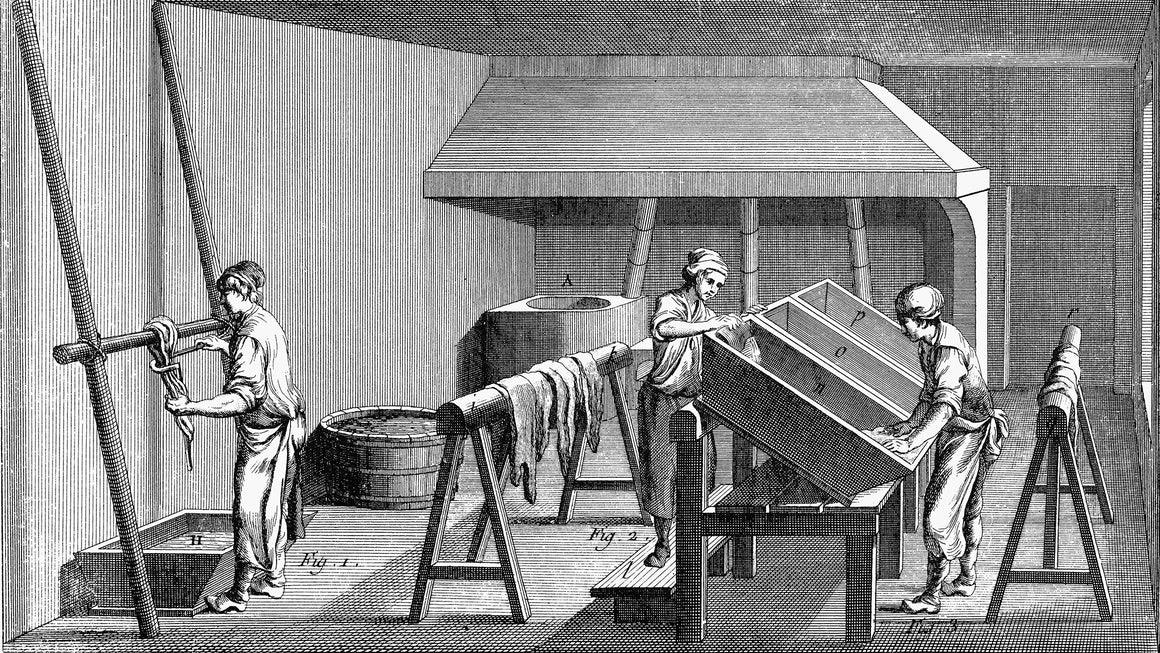Leather, as a true tribute to the innovation and skill of humans, has surely played an important role in the evolution of civilization. From the dawn of humanity to the present scenario, leather has been a constant in practically every era of contemporary designs. Let’s look at the history of leather craft and its applications throughout history.
ORIGIN OF LEATHER

The use of dried animal skins has been initiated in prehistoric times when primitive men started to employ early versions of leather for clothing and shelter to protect against harsh climate. Man has hunted animals and utilized as many parts of them as possible for survival since the advent of civilization. Throughout the prehistoric and stone-age period, man would typically wear animal skins with the fur still on them to guard them against the forces of nature. The first recorded bone awls occurred in South Africa between 84,000 and 72,000 years ago. It is thought they were used to penetrate leather fabrics based on their structure and patterns. The first recorded leather goods innovated by archaic tribes stretch back to 1300 BC when man began to value animal skins as more than merely a by-product of food.
HISTORY OF TANNING

Ancient civilizations all around the world began to develop their own processes for softening and preserving their animal hide by-products, employing methods passed down from generation to generation. Evidence for hide working, or scraping hides for tanning, has been prevalent for more than 400,000 years. It is said that the technique of vegetable tanning as it is known to date was initially discovered by the people of the ancient Hebrew community. Leather tanning was an extremely smelly procedure, and as such, tanneries were located far away from civilized areas so that the odor would not pose an issue.
Leather is certainly a long-lasting material that, when treated appropriately, becomes a smooth and comfy material. Because it is manufactured from animal hide, it can come from cows, buffalo, deer, horses, goats, wolves, foxes, rats, and rabbits. Leather can also be extracted from the hide of amphibians and reptiles such as snakes and alligators. Some rare creatures include fish, giraffes, and zebras. The majority of leather originates from cows.
The leather would be tanned by the Romans to produce a softer brown texture. Alternatively, they would dip it in alum and salt to create a softer, paler substance. Butchers’ unprocessed hides might be converted to rawhide and used to manufacture durable soles for the shoes.
The quantity of manufacturing leather artifacts increased manifold equipped with advanced tools and techniques, as civilization became more elite and industrialized. Professional tanners and leather workers formed advanced trade guilds during the Middle Ages to protect ownership of tools and control over the supply of goods. An alternative approach to vegetable tanning was not invented until the nineteenth century. Chrome tanning involves the use of chemicals that speed the manufacturing process, eliminating many of the preliminary procedures required for traditional vegetable tanning. Presently, chromium is used in 80-90 percent of tanning over the world.
AN ARRAY OF LEATHER ARTEFACTS
During the Homeric era, circa 1200 BC, the Ancient Greeks were known to have utilized leather to manufacture sandals as well as apparel. The earliest known leather footwear was discovered in an Armenian cave around 3,500 BC. To protect humans from natural calamities, animal skins were frequently utilized for clothing, footwear, and shelters. Leather was used for clothing such as head coverings, shoes, and general wear, while also venturing into other protective uses such as shields used in combat. Leather manufacture even extended to Egypt, where Pharaohs and Queens admired and cherished it, and then to Rome, where it was commonly employed by foot troops to construct defensive armories.
One can see the continued use of leather in other areas such as jewelry during the Iron Age i.e. between 1200 to 300 BC time. The jewelry range comprises all types of earrings, necklaces, bracelets, and brooches, which are finished with high-quality sterling silver fittings. Nowadays, fashion jewelry uses various forms of leather such as hard and soft leather. Leather can be dyed, painted, carved, embossed and perforated. Leather is also used to craft a variety of products like shoes, jackets, bags, belts, wallets, leggings, pants, boots, and ladies’ blouses and skirts.
Ancient Greece witnessed a surge in leather footwear production. Sandals were popular footwear in this era. Leather continued to be used for protective purposes such as in the construction of shields and armor, and it even evolved into the making of leather bags to hold other objects.
Leather was also widely used by the Romans, mostly as a raw material. Clothing, shoes, shields and belts, harnesses, boots, saddles, and tents were all made from it. The leather materials were heavily used by the Roman soldiers.
Leathercraft and the diverse uses for leather items flourished throughout the Renaissance such as shaping, stamping, and molding for artistic and functional purposes. This period also saw the widespread use of animal skin in jackets, trousers, leather gauntlets, dresses, hangars, pouches, satchels, slings, hats, shields, and other forms of physical protection, along with equipment for the protection of horses as well as saddlery and accessories.
EVOLUTION OF THE EVERGREEN CRAFT
Throughout the Middle Ages, the popularity of leather craft and technology grew manifolds. Far more was accomplished by tooling, painting, dyeing, and carving. Apparel, knife covers, footwear, parchment, saddles, books, boxes, and even aesthetic products have all been made from it. Utilitarian products such as satchels, pouches, aprons, bags, belts, and hats were also crafted from leather. Leather is not just used to make garments, but also has long been associated with the bookbinding industry due to its popularity throughout the Victorian era. Novels by famous authors have been immortalized in gilded leather, and early editions are now worth hundreds of pounds at auction.
The leather craft business saw a significant shift during the period of the Industrial Revolution. Industry machines enabled significantly faster manufacture of finished leathers. The use of leather in the machine belts that drove them benefited the machines as well. During the midst of the Industrial Revolution, leather manufacturing reached its heights. It was around 1818 when Patent Leather was invented. It is a technique of coating leather with a high gloss finish which lends an appealing look.
Even though leather from animal hide has been in the industry for years, artificial or man-made leather is a development in the last few centuries. After the procedure for crafting real leather was more perfected and developed, artificial leather was invented. Synthetic leather was essential for areas and industries that needed widespread production, or where it was quite a task to procure leather. Now let’s look into the world of artificial leather.
DISCOVERY OF ARTIFICIAL LEATHER
Several scholars and academics are of the opinion that in the 14th century, the Chinese produced a parasol-resistant material with qualities akin to synthetic leather. Following that, various attempts were made over the years to develop a petroleum-based plastic fabric that was more resilient and effective.
Presstoff, a type of early synthetic leather made from paper pulp, was one of the first. During the Second World War in Germany, the supply of genuine leather was restricted, thus synthetic leather was produced to meet the need for leather. However, Presstoff’s influence was confined within Germany, and consumers began to choose other leather options. The major cause of its degeneration was that it could not withstand constant abrasion and dampness.
After extensive study, the US Rubber Company, founded in 1892, created Naugahyde in 1920. Synthetic leather acquired appeal in the worldwide market with the discovery of Naugahyde. Naugahyde was first used to make handbags and continued to stay high in demand as a replacement for genuine leather for many years, particularly in the 1930s and 1940s.
Many firms attempted to make synthetic leather after the 1950s until the twentieth century when people realized the negative and destructive impact of synthetic leather. As public awareness grew, numerous firms began to experiment with non-biodegradable and environmentally friendly alternatives to leatherette. Many firms have developed vegan leather with their expert development team, but they are yet to make a substantial impact in the industry.
MODERN-DAY LEATHER INDUSTRY
Leather is now widely employed in a variety of sectors. Tanning can be done in a variety of ways, such as vegetable, chrome, aldehyde, brain, and alum tanning. It comes in a variety of grades and hues and is utilized in almost every aspect of life. From natural to artificial leather- there’s an equal demand for both varieties in the modern-day world.
Almost everyone has a leather item they use as a part of their everyday life, whether it’s a purse, keyring, wallet, apron, hat, and a lot other things. It’s fascinating to realize how far leather has progressed over eons. It’s also interesting to note how familiar some of the manufacturing processes and applications are, even after so many years. Leather is indeed a classic material.
Craftsmanship, quality, and heritage are of utmost importance in the field of leather making. Thus, the modern leather clothing and accessories industry is always taking inspiration from older times. From tough leather boots reminiscent of Western cowboys to the vintage aviation look that exemplifies the WWII era, modern fashion designers continue to draw on the past for inspiration when crafting leather goods as per recent trends.
Historical trends will always be a reminiscence of the origins of the craft and create an impact on the recent styles to date. Leather designers, on the other hand, are constantly looking for fresh and imaginative methods to highlight this iconic material and its versatility. Exotic rawhides like crocodile, snakeskin, and ostrich, as well as distinctive leather finishes like patent and suede, have become increasingly popular on runways and on the covers of high-fashion luxury magazines. While it is a real task to forecast future fashions or trends, it is fair to assume that leather will always have a role in modern culture, whether for aesthetic or usefulness.




 Mobile/What's App/Wechat
Mobile/What's App/Wechat E-Mail
E-Mail ADD
ADD




